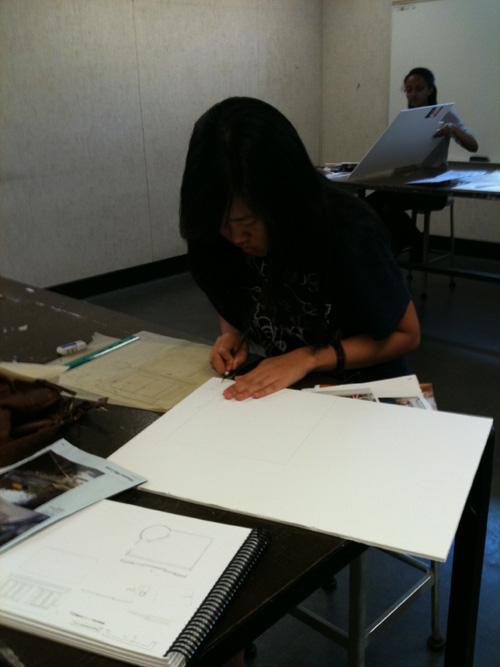Week five of the Saturday High Architecture class at Art Center College of Design. The theme is "orchestrating experience on a different scale: 10 ways to prepare for success." Peter Lawrence said: "Design is the term we use to describe both the process and the result of giving tangible form to human ideas. Design doesn't just contribute to the quality of life; design in many ways, now constitutes the quality of life."
Our vocabulary for today is as follows:
ambiguity-the anxiety that comes from not knowing what to do, vagueness or uncertainty of meaning.
continuity-a state or quality of being continuous.
attunement-a state or quality of achieving a harmonious or responsive relationship.
We start our three-hour work session with a pin-up. Sam's parti is "Flow." She is designing a study which is all about books and light. Last time I suggested that she needs to consider the nature of books and their accessibility--having bookshelves above a full-height window might not be an ideal approach. She comes back with a model that clearly shows evolution. The books are not interrupted by the window. In fact, in the spirit of flow, the window continues as the vertical plane of the wall transforms into a sky-lit ceiling. To further enhance her concept, Sam opts to do away with a door--something to stop you--an arched opening marks the entry well.
John's idea is to "follow the sun." He is proposing a structure that is ¾ of a circle with a continuous balcony. Ground floor glazing is translucent to "protect privacy," whereas the upper floor has transparent fenestration, inviting the view.
Using Martin's model, I attempt to explain the concept of hierarchy--even though all the rooms appear the same, position of a door suggests differentiation. There will be a whole lesson devoted to it, but I feel that it is important to talk about it already.
Shawn's original bold gesture of "playground" is getting diluted with functional considerations. His challenge is not to compromise, not to abandon initial clarity and simplicity. He almost needs to go back.
Sophia is the last one and I almost overlook her. She speaks up and reminds me. This is wonderful: she tried to avoid being "put on the spot" before. This change in itself is huge. Clearly, she is preparing for success! Her project takes a very different approach from everyone else's. Sophia manipulates the ground plane to delineate separate areas by defining space with steps, not walls.
As we go through everyone's work, I stress the idea of the process, of going back and forth. It pleases me that they take my words to heart. I sense that I earned their respect. Good thing, I have something encouraging to say to all of them individually!
Today's lecture is quite simple. I unroll a set of architectural drawings for a house to point out various details and answer questions. The sheer volume of documentation is fascinating to them. They are very engaged.


I end the class with a quote from Virginia Woolf: "The success of the masterpieces seems to lie not so much in their freedom from faults... but in the immense persuasiveness of a mind which has completely mastered its perspective." What does that mean?
